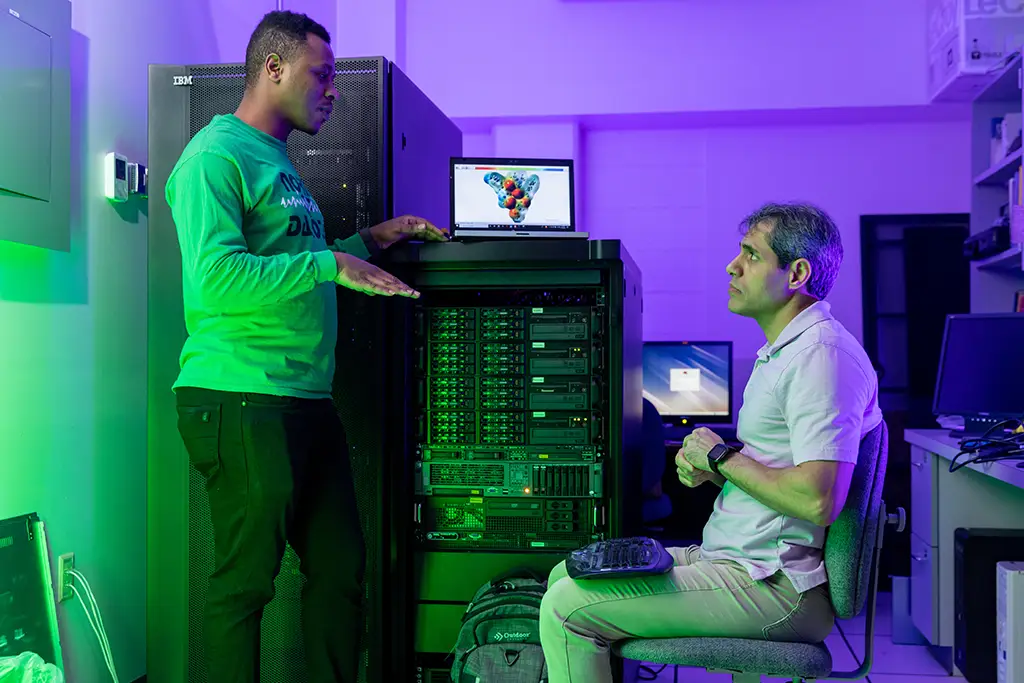
Machine Learning vs. AI: Definitions, Types, and Uses
Every time you ask Siri a question, scroll through Netflix recommendations, or unlock your phone with your face, you are using tools powered by AI or ML.
Request Information
Many people use the terms interchangeably, but they aren’t quite the same. While they work closely together, understanding their differences can help you understand how modern technology works.
Today, as more students explore careers in computer science and data-driven fields, understanding what AI vs. machine learning is essential.
Key Takeaways
- AI is a broader field that focuses on creating intelligent systems that simulate human intelligence, while machine learning is a subset of AI that enables machines to learn from data.
- AI and ML are part of every tool, including personalized education tools and smart assistants.
- UND offers multiple academic pathways, including a graduate certificate and a Ph.D. program, to help students succeed with the top employability skills.
What is Machine Learning?
Machine learning is a type of technology that helps computers learn from data and improve over time without exact guidelines.
Instead of following step-by-step instructions, the system looks at patterns in data and uses those patterns to make decisions. For example, when Spotify suggests songs you may like, or when banks detect unusual activity on your account.
Types of Machine Learning
There are three primary categories of machine learning, each with its own set of learning and problem-solving techniques. It includes:
- Supervised learning: The system makes predictions based on labeled data that already has correct answers, like a student studying with an answer key. A common example includes email spam detection, where the system recognizes spam based on previous examples.
- Unsupervised learning: The system finds patterns in data without labels or answers. This type is often used for tasks like customer segmentation, where businesses categorize users based on behavior.
- Reinforcement learning: The system makes decisions, learns by making mistakes, receives feedback in the form of rewards or penalties, and gets better over time. It’s used in robotics, self-driving cars, or game-playing AIs.
What is AI?
The creation of systems that are capable of human-like functions, like problem-solving, language comprehension, and image recognition, is the focus of the large field of computer science known as artificial intelligence.
Machine learning is just one part of AI, as there are many other areas within it. For example, AI is used in robotics (like warehouse robotics), natural language processing (like chatbots or virtual assistants), and gaming (like opponents that adapt to your moves in video games).
Types of AI
Artificial intelligence is often grouped into three categories based on its abilities and scope:
- Narrow AI (also called weak AI): This type of AI is designed to perform a specific task and cannot move beyond what it was programmed to do. Examples include virtual assistants like Alexa, spam filters, or recommendation systems on Hulu.
- General AI (also called strong AI): This is a more advanced but hypothetical version of AI that can understand, learn, and apply knowledge across different tasks, like a human being. Examples include self-driving cars, the IBM Watson Assistant, and ROSS legal expert intelligence.
- Super AI: A theoretical concept of AI that would surpass human intelligence in all areas, including creativity, problem-solving, and emotions. Although it is still imaginary, examples would include AI characters in movies such as Her or Ex Machina.
Key Differences Between Machine Learning and AI

Building on how these two work together, it’s also essential to understand how they differ. Knowing their differences helps you see how each one is used in real-life situations, including the apps on your phone.
In this section, we’ll break down their differences across scope, approach, dependency on data, and adaptability.
Scope
AI is the broader concept. It covers any method that allows machines to perform tasks that would otherwise require human intelligence, such as reasoning, problem-solving, and decision-making.
Machine learning sits inside that larger field. It’s a specific application within AI that focuses on teaching machines through data. While AI aims to create intelligent behavior, machine learning narrows that purpose down to developing systems that improve their performance automatically by learning from examples.
Approach
AI tries to simulate human intelligence in different ways. Some AI systems are built on rule-based frameworks; for example, an expert system in healthcare that follows “if-then” rules to suggest a diagnosis.
Machine learning takes a different approach. It focuses on recognizing patterns, relying on algorithms and models that train data, rather than manually coded rules. A machine learning system figures out how to solve a problem through patterns in large data sets.
This is why ML has become central to modern AI; the amount of data available today allows these models to improve and find data that other AIs might miss.
Dependency on Data

Machine learning is deeply dependent on data. The more data you provide, and the cleaner and more accurate it is, the better the model becomes. For example, a machine learning system that predicts equipment failures in a factory improves after being trained on millions of sensor readings.
In contrast, AI doesn’t always require massive data sets. Traditional AI can work with a set of predefined logic, such as a chess program that follows a decision tree of moves without learning from new data.
Adaptability and Learning
A key strength in machine learning is its ability to adapt over time. ML systems learn from each new data input to improve their performance.
A great example of this is the navigation app. When drivers use it, the app collects data about traffic patterns, road closures, and travel speeds. Over time, the system improves and suggests the fastest routes based on current conditions.
Some AI systems, especially older or rule-based ones, don’t have this kind of adaptability. They follow fixed instructions and can only change if a programmer updates them manually.
How Machine Learning and AI Work Together

Artificial intelligence is about building systems that can think and act in smart, human-like ways. Machine learning improves those systems by helping them learn from data and improve over time, instead of following fixed instructions.
AI is a broader field where machines can make decisions, solve problems, or understand information. On the other hand, machine learning is the method that teaches them to get smarter with experience.
You can see this combination in action everywhere. Recommendation systems on streaming platforms suggest movies or music by using AI to figure out what you might like, while machine learning studies your viewing or listening preferences to make those suggestions more accurate.
In healthcare, AI can analyze medical images, and machine learning helps it improve by identifying patterns that show early signs of illnesses. Machine learning algorithms power most major AI breakthroughs. Examples include chatbots that understand natural language and tools that predict equipment failures in industries.
Benefits of AI and Machine Learning
AI and machine learning offer numerous benefits across various fields, as they remain the top skills employers seek in their employees.
- Automation: AI and ML automate repetitive or time-consuming tasks, like freeing up human workers for higher-value activities. For example, in education, AI can grade assignments and track student progress, while businesses use chatbots to manage customer service 24/7.
- Improved accuracy: Machine learning models can process vast amounts of data and identify patterns with greater accuracy than manual methods. In healthcare, AI tools help doctors spot early signs of disease, and in technology careers, developers use ML-driven testing to catch bugs before release.
- Predictive analytics: ML models can predict future trends by learning from historical data to enable proactive decision-making. Companies predict demand and optimize supply chains, while schools use analytics to identify students who need extra support.
- Personalized experiences: AI and ML models offer personalized experiences for individual needs. Adaptive learning platforms can create lessons based on student performance, and healthcare systems design treatments for each patient’s profile.
Which One Should You Focus On?

If you are a student or someone planning a career in tech or data-related fields, both artificial intelligence and machine learning are areas worth exploring. They often overlap, but the best focus for you depends on your interests and long-term goals.
AI is broader and encompasses the design of systems that perform tasks that require human intelligence. If you want to innovate across robotics, natural language processing, or human-computer interaction, a focus on AI will help you see a wide range of emerging technologies.
On the other hand, machine learning is a core subset of AI that focuses on data analysis, model building, and predictive modeling. If you enjoy working with data sets, creating algorithms, and improving the way systems learn from information over time, ML might be the right choice for you.
At the University of North Dakota (UND), you don’t have to choose between them too early. The Graduate Certificate in Artificial Intelligence and Machine Learning covers both fields. It has flexible certificate requirements that allow students to personalize their learning according to their professional interests.
It offers formal training in foundational and advanced algorithms, with hands-on experience in computer science, data science, and electrical engineering. The program provides you with the necessary theory and a toolkit of techniques that you can use in the workplace.
Additionally, UND offers undergraduate and graduate pathways for students interested in AI, machine learning, and data-driven careers:
- Computer Science offers undergraduate and graduate programs with electives in AI, data analytics, and software engineering.
- Electrical Engineering focuses on applying AI and ML to embedded systems, automation, and control technologies.
- Data Science prepares students for in-demand data science roles by combining machine learning concepts with statistical modeling.
If you’re looking to take your education even further, consider UND’s Artificial Intelligence Ph.D. program. This program is research-based, helping you explore new methods in AI and machine learning and contribute to the field’s academic progress.
Both AI and ML are reshaping the future workforce. Whether you lean toward the innovation of AI or the data-driven depth of ML, UND has a range of programs to prepare you for a successful tech-driven career.
Conclusion
Machine learning and artificial intelligence are interconnected, as ML gives systems the ability to learn and improve, while AI offers the broader goal of creating machines that think and act intelligently.
Understanding their differences helps you see how they are applied in real projects, like improving education platforms or driving innovation in research labs.
As their impact continues to grow every day, this might be the right time to get involved. If these areas spark your interest, take a closer look at UND’s programs. Explore what each path offers and choose the one that fits your goals.
FAQs
Rule-based systems, also called expert systems, are AI but not machine learning, as they follow programmed logic without learning from data.
Machine learning is considered a form of AI when it enables a computer to learn and make decisions like how humans would.
AI refers to any smart computer system, machine learning helps it learn from data, and deep learning uses brain-like networks (including AI in Siri, ML in Netflix recommendations, and DL in self-driving cars).
Some disadvantages of AI and machine learning include the risk of biased or unfair decisions, a lack of transparency in how systems make decisions, the need for large amounts of data, and the potential for replacing certain jobs.